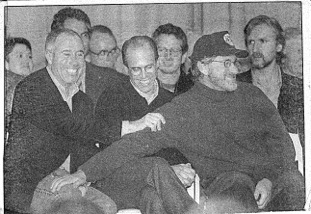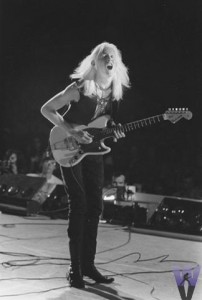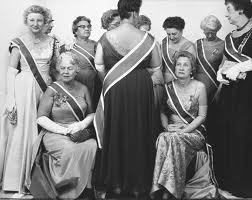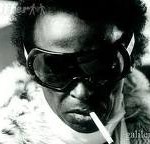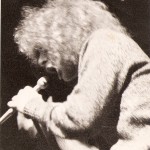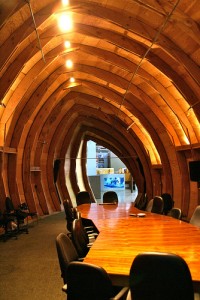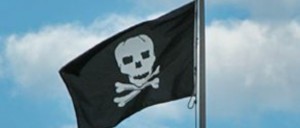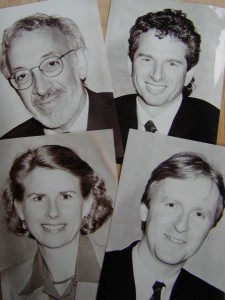The Eleventh Commandment
03 Dec 2011
I was never the guy that everyone just “liked”. Those folks, the one’s that everyone “liked”, seemed boring to me. People either loved me or hated me.
No one could ever call me boring… they could call me lots of other things, but boring, never.
I just tried to be me, and in my mind, that was righteous. Others, however, saw it as outrageously self righteous.
I never could understand why people had issues with me. I always thought I did the right thing.
After all, I came from nowhere. A street kid from “da Bronx” with no money, no future and no boundaries. I never gave a thought about “making a living” or starting a family or even a future for that matter. All I ever wanted to do was play music, have a good time and as a child of the sixties, stop war on our planet. In retrospect, I’m not sure I did any of them. Well, I guess I did have a pretty damn good time.
I had a big birthday last week, one that ended with a zero. I spent all of my life acting young but thinking I was old. At 3o, I didn’t even trust myself. At 4o, I thought I had one foot in the grave ( I am, after all, a hypochondriac). At 50, I got an expensive gold watch from my coworkers, a sure sign that it was all but over. I spent so much time worrying about getting old that I never appreciated being young.
I’ve finally slowed down enough to have a little perspective, and to be a bit introspective.
I recently asked people to help me focus on a theme for my newest blog entry. Someone sent me an email asking me to consider writing about “the road not taken” and some of the mistakes I’ve made along the way. Perfect timing, an opportunity to really consider my screw ups, just as I turned 60.
Being raised Jewish, having gone to Hebrew school, Bar Mitzvah-ed, and raised by a mother named Ruth, I was well aware of the Ten Commandments and being a street kid, I broke most of ’em. But the one commandment I was never taught was the eleventh commandment, “Thou Shall Not Believe Thine Own Hype”.
Throughout my life, I thought that I was the smartest person alive. In fact, I knew I was.
Some of you might remember that at SIGGRAPH ’97, Digital Domain had given out black tee shirts that proudly proclaimed:
James Cameron/Stan Winston Studio/Digital Domain
AVATAR
As a result of financial issues surrounding TITANIC, Cameron had tried to make good to the company he helped found by offering DD a”back end” participation on his next epic. In the late 90’s it was obvious to me, and everyone else that read AVATAR, that the images that Cameron envisioned were practically impossible. Clearly there was a need to do massive amounts of R&D for even a proof of concept, let alone mounting a production.
Twentieth Century Fox was prepared to fund a fairly expensive test. Unfortunately they (Fox) wanted to own the code that DD developed. Being the “smartest guy in the room”, I assumed that the software developed for creating the “Navi” would be worth much more than receiving profit participation in AVATAR. I mean, how much could a movie make?
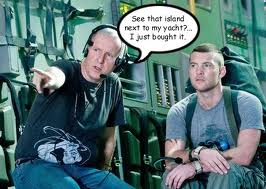 The rest is, as they say, history.
The rest is, as they say, history.
As a kid, I only got into a fistfight once (my fifth grade classmate, Abe, said my Mom smelled like dogshit… what was I supposed to do?)… but, I never backed down from a fight. I was little, skinny and quick tongued. I didn’t have much of a left hook but I had one helluva mouth.
I could talk my way out of anything, or so I thought. I was a 92 pound weakling with two hundred pounds of bullshit and attitude.
Sometime in the early part of the last decade, I was invited to give a presentation in Korea. At the time, I was knee deep in a messy divorce and would do most anything to get as far away as possible, preferably Asia.
And, speaking in front of crowds… well, that was easy for me, so easy that I always just “winged it”.
One morning, I was picked up by my favorite limo driver, Berndt, driven to LAX and boarded a KAL 747 and flew to Seoul. Upon arrival, I was met by several Korean officials and whisked off to the InterContinental COEX, where, still terribly hungover from Ambien and severely jet-lagged, I was shown to my room. I unpacked, took a quick shower and considered my options. I could call a buddy and go out on the town or I could stay in and try to outline my speech for tomorrow’s presentation.
The choice was obvious.
I arrived back at the InterContinental Hotel at about 3 AM. After countless hours of Karaoke and dozens of shots of Shochu, I was toast. My internal clock was set to Pacific Standard Time, but the clock in my room read “3:19”. My speech was in less than 7 hours. I hadn’t planned my talk. I hadn’t even looked at what the conference was about. What hubris. I scanned the room for the bag that they handed me at reception when I checked in. You know, those cheap, “wanna be fake computer bags” with the conference logo stenciled on the front flap. The ones that you will never use again because it says something dumb like, “with our collective vision, we can change the world”…. XYZ Industries, Kyoto 1995.
There it was, lying on the floor, next to the desk. I opened the flap, pulled out the brochure and stared at it for a bit. After a couple of seconds my eyes finally focused, it said “World Economic Forum, Seoul Korea”. World Economic Forum? Why the hell was I asked to speak at an economic forum? I scanned the speakers list. There were dozens of names. It seemed like every speaker was the chair of some Economics Department at a major university… Harvard, Stanford, Cambridge, Yale, Oxford and so on. The theme of the conference was how to transform Korea and move it from the 11th largest economy in the world into the top 10.
My degree was in Communications and while I was adept at business, the only thing I knew about Economics was the theory of “supply and demand”. While at that very moment my body demanded sleep, I needed to write a speech. All my fears of not making the honor roll, failing my Geometry final and every other academic nightmare surfaced. I was scared to death. When I got on the plane that day, I assumed that if I showed the Digital Domain demo reel, everyone would be so wowed that it really wouldn’t matter what I said. I spent the next several hours sobering up and writing an outline.
At 8 o’clock I put on a suit and tie ( it was after all, an economic forum with PhD’s and stuff) and headed to the COEX convention center which was connected to the hotel via an underground passageway. I always liked getting the feel of a room before I spoke and I always wanted to check DVD playback to make sure that the contrast, brightness, hue and saturation levels were correct. That day, I also figured that maybe I could hear the speakers before me and get a better sense of what the conference was about.
I asked the fellow at the information desk where the conference was being held. He waved me in the direction of a double door, which I opened.
My jaw hit the floor, my stomach did several flips. The “room” was gigantic, filled with about 3000 people. There was TV coverage and it was lit to about 150 foot candles… so bright that I wish I had applied SPF 50 .
Before I knew it, my name was being announced. Digital Domain’s demo reel played. It did the trick, after the Powerpoint of the previous speaker, the audience was blown away by the visual effects on APOLLO 13 and TITANIC. I walked up to the podium, freightened because I couldn’t wing this one, like I did most everything else in my life.
I compared Korea’s economy to THE WIZARD OF OZ (must have been the Ambien) … something about the yellow brick road and believing that there was a path to the future. I told the audience that believing was the critical part and that there truly is “no place like home”. I went on talking about surfers needing to look to the horizon, to see the next set of waves, not just the next wave. I spoke about Korea needing to move from a manufacturing culture to a content culture, to stop just making TV’s and to start making TV shows … video games and movies (after all I was always looking for funding for a content play).
I finished my 45 minute presentation and afterwards I was asked bunches of questions by the press.
“Do you like Korean films”?
“Do you like Korean food”?
“Do you think Korean animation and visual effects are good”?
I guess I answered the questions correctly because I was invited to have breakfast the next morning at the “Blue House” (Korea’s version of the White House) by Korea’s then President, Roh Moo-hyun.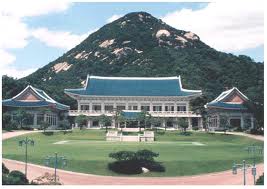
The President of the Republic of Korea had invited me to breakfast, damn.
The next morning I was picked up by a black car and driven to the Blue House. With the help of an interpreter, we “chatted” throughout breakfast.
” Is Kim Chong-Il crazy and will he use nuclear weapons ?” , I asked.
“No, he’s not crazy at all, he just wants the world to believe he’s crazy and that he might use nuclear weapons”, the President of Korea answered. ” He needs money desperately, and if he acts crazy and threatens using Atomic Bombs, someone might pay him not to” Roh, continued.
” That’s what frightens me, if he’s only interested in cash, then some terrorist organization with lots of oil money could buy his nukes”, I said.
” Oh, there’s nothing to fear, Kim Chong-Il will sell them to the highest bidder … and the highest bidder will be the United States”, Roh responded.
I thought to myself… ” I hope “the Dear Leader” fully understands the Eleventh Commandment”.
After all, it took me 60 years to stop believing my own hype.


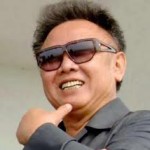

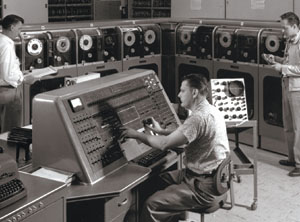
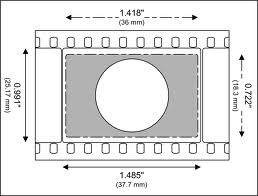
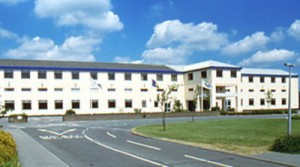



 The elevator doors slowly opened, revealing Sandy Climan’s smiling face and outstretched hand. In an instant the women had disappeared only to return seconds later with beverages and the ubiquitous LA greeting ” Would you like something to drink ?” I personally believe we could put a major dent in water shortages around the world if people in the entertainment business did not accept the mandatory bottled water upon the start of every meeting.
The elevator doors slowly opened, revealing Sandy Climan’s smiling face and outstretched hand. In an instant the women had disappeared only to return seconds later with beverages and the ubiquitous LA greeting ” Would you like something to drink ?” I personally believe we could put a major dent in water shortages around the world if people in the entertainment business did not accept the mandatory bottled water upon the start of every meeting.